Jarama Series The Regiments
In the Jarama Series, The Volunteer Blog will present a series of articles examining the experiences of volunteers in the Abraham Lincoln Battalion from its formation to the Brunete Offensive in July 1937. Articles will focus both on the battalion’s formation as well as on the individuals who served. These articles are intended to provide the reader with a better appreciation of the men and women who made up the first American combat formation in Spain.
Jarama Series #16 The Regiments
In the spring and early summer of 1937, the XVth International Brigade (XV IB) reached its highest point in combat strength. A robust headquarters element, six infantry battalions, an anti-tank battery, and cavalry squadrons positioned the XV IB well to contribute to the Republican’s first major offensive. The 15th Division ordered the addition of an additional layer of command to accommodate the XV IB’s growth in strength. Part of this restructuring included the formation of two groups or regiments. The Dimitrov; 6th of February; and the Spanish 24th Battalions made up the first regiment/group and the Lincolns, British and newly arrived Washington Battalion made up the second/group.
The XV IB’s battalions were close to full strength with a cadre of combat veterans in each of the international battalions. Replacements from the training bases, along with the assignment of a Spanish Company to each battalion, increased strength and allowed each of the battalions to field three infantry companies and a machine gun company.[i] The XV IB’s Estado Mayor (Headquarters) included not only the command staff, but also a number of subordinate formations that provided mix of sustainment and combat elements (see Figure 1). These consisted of:
- The Signal platoon, in Spanish Transmisiones, established and maintained the brigade’s communication with subordinate elements. They accomplished this by laying wire between the units. When the wires were cut, teams were dispatched to trace the wire and make repairs. This duty often occurred under fire. There is no definitive date for which this formation joined the EM.
- The Auto Park consisted of dispatchers, drivers, mechanics and the rolling stock assigned to the brigade headquarters. The EM vehicles included trucks, sedans and motorcycles.
- Fortifications provided engineering support to the brigade headquarters and subordinate units.
- Medical, in Spanish Sanidad, provided health support and combat casualty care to the brigade headquarters.
- The Armory provided ordnance support supplying ammunition and small arms maintenance.
- The Cavalry Squadron provided reconnaissance and straggler policing. The squadron was destroyed in combat during the Brunete Offensive.
- The British Anti-Tank Battery was equipped with three, state-of-the-art, Russian 45mm anti-tank guns.
- The Quartermaster Section was an amalgam of various sections and teams in the Estado Mayor that provided cook support, supply, mail and water to the headquarters and supported regiments.
- The Scouts provided reconnaissance for the headquarters.
- The Military Police, in Spanish Vigilancia, provided guards for the headquarters and enforcement of military rules and regulations.
- The Topography section obtained, drew, copied and distributed maps for the brigade headquarters and subordinate units.
- The Reserve Battalion consisted of recruits from the training sites who were sent to the battalions to replace combat losses. They existed only as a replacement pool.
- One or more artillery batteries were under the operational control of the XV BDE at various times before and during the Brunete Offensive.
Figure 1. Organization of the XV IB.
Each of the six battalions in the two regiments had a similar organization. Each nominally possessed a company-size headquarters, three infantry companies, and an MG company. The Plana Mayor included the battalion’s staff and supporting sustainment and combat support elements (see Figure 2). Each battalion included:
- Battalion Scouts conducted reconnaissance forward of the battalion’s main body during tactical movements.
- Quartermaster and Kitchens provided sustainment to the Plana Mayor and subordinate companies.
- Armory- provided ordnance support supplying ammunition and small arms maintenance.
- Battalion Transport provided maintenance and drivers for the Battalion’s rolling stock.
- Signals, in Spanish Transmisiones, established and maintained the battalion’s communication with its companies.
- Runners carried messages to higher headquarters, subordinate elements and other Brigade units. This duty was particularly hazardous as it, at times, required moving rapidly under fire to deliver messages.
- Topographers obtained, drew, copied and distributed maps for the brigade headquarters and subordinate units.
- Medics, in Spanish Sanidad, provided health support and combat casualty care to the battalion.
Figure 2. Typical battalion formation
While on paper the brigade was in excellent shape, it had significant shortcomings. Chief among them was the limited time the brigade had to train after the long trench vigil at Jarama. Due to the static nature and demands of trench warfare, it was impossible for leaders to train at greater than platoon level at any one time. Life in trenches also left the men ill-prepared physically for the demands of mobile operations. The George Washington Battalion, though lacking combat experience had a longer training period than any previous international infantry unit and was in the best shape for mobile warfare.
The new group/regimental structure also presented issues. Because it was formally instituted just before the brigade went into action, staffs had little time to become cohesive. They also lacked time to integrate their staff work within the brigade and the newly formed 15th Division.
XV IB leadership tried to compensate by issuing daily training programs to help the commands brush up on their combat skills. Very little time was allotted to maneuvering at the battalion level and it is debatable whether the units strictly adhered to the schedules.[ii]
General Janos Gal commanded the 15th Division.[iii] The 15th division was composed of the XIII and XV IBs. The command structure of the XV BDE is depicted below.
XV International Brigade[iv]
Commander, Vladimir Copic[v]
Commissar, George Aitken[vi]
Chief of Staff, Teniente Coronel, Hans Klaus[vii]
Operations
Chief of Operations, Mayor George Nathan[viii]
Adjutant Teniente Leon
Chief of Information Section
Frantz Berger
Special Staff
Captain Luis Garcia Marquez in charge of three new sections
- Munitions
- Water
- Recuperation of Arms and Munitions
Liaison to 15 DIV HQ
Teniente Joseph Pasdrnak
Armory and Munitions
Teniente Roberto Rinaldo (20 May)
Auto Park
Commander, Teniente Andre Dugue (20 May)
Adjutant, Teniente Jose Melchor (20 May)
Service Sanitario
Chief, Capitan Dr. Alex Langer (20 May)
Intendencia
Engineer Company
Transmissiones
Vigilancia Militar
Cavalry Squadron
Commander, Captian Tommaso Allocca (20 May)
Adjutant, Teniente Robert Dallier (20 May)
Brigade Anti-Tank Battery
Commander Malcolm Dunbar[ix]
Commissar Hugh Slater[x]
First Group/Regiment
Commander, Major Gabriel Fort[xi]
Battalion 24, Spanish Voluntarios
Commander, Gabriel Martinez Esclapez
Commissar, Emilio Fronteriz
Adjutant, Teniente Migal Ivare (20 May)
Battalion 14, Dimitrov
Commander, Captain Michel Tsapajiev aka “Chapiev”[xii]
Commissar, Steve Tabakov (speculative)
Adjutant, Teniente Louis Mate (20 May)
Battalion 15, 6th of February
Commander, Captain Maurice Blin
Adjutant Teniente Marcel Lantez (20 May)
Second Group/Regiment
Commander, Major Jock Cunningham[xiii]
Commissar, Harry Haywood[xiv]
Adjutant, Captain Martin Hourihan[xv]
Battalion 16, British
Commander, Captain Fred Copeman[xvi]
Commissar Bert Williams[xvii]
Adjutant Teniente Charles Goodfellow (20 May)[xviii]
Battalion 17, Abraham Lincoln
Commander, Teniente Oliver Law[xix]
Commissar, Steve Nelson[xx]
Adjutant, Vincent Usera[xxi]
Battalion 19, George Washington
Commander, Captain Mirko Markovics[xxii]
Commissar, Dave Mates[xxiii]
Adjutant, Robert Trail[xxiv]
[i] The English Battalion’s MG company was No. 2 Company.
[ii] RGASPI Fond 545, Opis 3, Delo 426, ll.195-196, Orders of the day for June 28 and June 29 include instructions for all subordinate units to practice company and battalion movements. Time allotted for this practice.
[iii] Galicz, Janos. b. 1890 in the former Austro-Hungarian Empire. In Spain he went by the nom de guerre General Gal. Galicz was a soldier in the Austro-Hungarian Army in WWI and was captured by the Russians on the Eastern Front and subsequently joined the Red Army. He served in Bela Kun’s Soviet Republic in Hungary and was an exile in the Soviet Union after the republic was crushed.
Galicz was the first commander of the XV IB before being promoted to division command. Gal was recalled to Russia in 1939 and was likely executed during the purge.
[iv] This incomplete list of commanders and units for the XV IB is compiled from two main sources: ORDEN DEL DIA 3 de Julio de 1937 [this order of the day lays out the two groups/regiments], RGASPI Fond 545, Opis 3, Delo 426, ll. 207; and RELACION DUPLICADA DE LOS JEFES Y OFICIALES DE LA EXPRESADA QUE SE FORMULA EN CUMPLIMINEO DE LA ORDEN GENERA DEL C. de E. NUM. 63 DE FECA 20 DE MAYO DE 1937. [A list of all officers in the brigade, this list does not include commissars and reorganizations may have occurred after this date individuals identified in through this document are followed by “(20 May)”] RGASPI Fond 545, Opis 3, Delo 452, ll. 10-15.
[v] Copic, Vladimir. b. March 8, 1891 in the former Austro-Hungarian Empire. A Croatian he served in the Austro-Hungarian Army during the First World War. He was captured by the Russians on the Eastern Front and subsequently joined the Red Army. He was a leader in Yugoslavian Communist Party and was a student in the Lenin School in Moscow during the 1930s.
Copic came to Spain and was appointed Commissar for the newly created XV IB. When Janos Galicz was promoted to command the 15th Division Copic was promoted to command the XV IB. Copic led the brigade from February 1937 into April 1938. Copic was recalled to Russia and was imprisoned
[vi] Aitken, George Sutherland. b. 1894 in Airdrie, Scotland. Aitken was the XV IB Commissar during the Brunete Campaign. A WWI veteran he joined the CPGB in 1920. Aitken served as a party organizer and was a member of the Amalgamated Engineering Union. He was also an alumin of the Lenin School in Moscow. He volunteered to serve in the International Brigades and arrived in Spain in late January 1937. He replaced Douglas Springhall as Commissars of the British Battalion and served at Jarama. He was promoted to Brigade Commissar before Brunete. He was one of five leading British officers recalled to Britain in the late summer of 1937. Harry Pollit decided to keep Aitken in Britain.
[vii] Klaus, Hans. Served in WWI in the German Army. He joined the CP in 1927 and after the Nazis came to power he went into exile in France. He arrived in Spain in the first weeks of the civil war. He served as the chief of Staff under Gal and later Copic.
[viii] Nathan, George Montague. b. circa 1895 (or 1897). Nathan was an instinctive soldier. He joined the British Army during the First World War and rose through the ranks receiving a field commission into the Warwickshire Regiment in 1917. Post war he tried several vocations including a stint in Canada as a farmer without success. He attempted to rejoin the Army but was discharged after brief terms of service. Nathan also served with the notorious Black and Tans in Ireland.
In 1936 Nathan volunteered to serve in the International Brigades. He led the No. 1 British Company and briefly commanded the Marseillaise Battalion in early 1937. Nathan transferred to the British Battalion as a staff officer and served at Jarama. Hethen served as a staff officer with the XIV IB. In the spring of 1937 he was selected to serve as the Chief of Brigade Operations. Nathan was killed during an aerial bombardment on July 16, 1937 at Brunete. Nathan is remembered as a resourceful, brave, and effective leader.
[ix] Dunbar, Ronald Malcolm Lorraine. b. February 12, 1912 in Paignton, Devon, England. Dunbar was a Cambridge graduate and a journalist. He arrived in Spain in early January 1937 and joined the British Battalion. Dunbar served as a group leader at Jarama and was wounded in the arm in February and after recovery attended the Officer Training School (OTS) at Pozo Rubio. Dunbar was selected as the commander of the newly formed Anti Tank Battery and served with it through the Brunete Campaign until he was wounded a second time on July 23, 1937. He later served as the XV IB Chief of Staff. During WWII he joined the British Army in 1940 as a Sergeant.
[x] Slater, Humphrey Richard Hugh. b. June 7, 1906, Carlisle, Cumberland, England. Slater was a Journalist and member of the CPGB from 1929 when he volunteered for service in Spain. He arrived in May 1937 and was selected as the Political Commissar for the newly formed Anti Tank Battery. Slater took command of the battery after Dunbar was promoted. Slater rose through the ranks and served on the Brigade Staff. He was repatriated in October 1938.
[xi] Fort, Gabriel. Fort commanded the first group/regiment. He was a French Socialist, a WW I veteran and Reserve officer in the French Army. Prior to moving up to regimental command he was the Commander of the 6th of February. He was wounded during the Brunete Campaign losing an eye. Despite the severity of the wound he returned to the Brigade.
[xii] Szalvay, Michael “Chapaev”. b. August 23, Budapest, Austria-Hungary. Was a day laborer and brick layer before WW I. During WWI he served in the Austro-Hungarian Army on the Italian Front. After the war he joined the CP in Hungary and served in the Red Army during Bela Kun’s short-lived Communist Regime. He was arrested and sentenced to 15 years. He escaped from prison in April 1920 and later lived clandestinely in Vienna, Brussels and Paris eaking out a living as a manual laborer. In 1936 he volunteered for the International Brigades. He rose to command the Dimitrov Battalion. After the war he crossed into France and was interred in a series of French concentration camps in Gurs, Vernet and in Africa in the Djelfában camp. In 1943 he went to the Soviet Union and served in the Soviet Red Army before travelling to Yugoslavia where he served in Tito’s headquarters and later participated in the liberation of Belgrade. After the war he served in the Hungarian Army receiving increasingly important commands, by 1954 he was a general and commanded the Unified Officers School. Szalvay died in Budapest on November 21, 1955.
[xiii] Cunningham, Jock. (Cunningham, Joseph Wallace); b. December 20, 1902 in Glasgow, Scotland. He joined the British Army and was arrested after leading a mutiny of the Argyll and Sutherland Highlanders in Jamaica against unacceptable conditions circa 1920 (1928/1929). Sentenced to six years’ incarceration, Cunningham served more than two years in the military prison in Aldershot. After his release he joined Communist Party of Great Briton. The CPGB lobbied for his freedom while Cunningham was incarcerated. In the years before the SCW broke out he worked as a miner and laborer; and was an active organizer for the National Unemployed Workers movement.
Cunningham arrived in Spain in early October 1936 and served in the Machine gun Company of the Commune de Paris attached to the XIth International Brigade (IB). In December he led the British No. 1 Company in the XIV IB during the fighting around Lopera. Cunningham along with the survivors of No.1 Company transferred into the British Battalion of the XV IB and he took command of the battalion after the disastrous first days of battle. In March he was seriously wounded leading a bombing party during the Dead Mule Trench battle.
After recovering from his wounds Cunningham returned to the XV BDE serving on the staff. He was selected to command the second group/regiment and led the unit during Brunete. After the death of George Nathan he served as acting Chief of Operations. Cunningham was recalled to Britain in late summer of 1937 along with Brigade Commissar George Aiken, Battalion Commissar Bert Williams, Battalion Commissar Wally Tapsell and Battalion Commander Fred Copeman. Harry Pollitt decided not to send Cunningham, Williams or Aitken back to Spain. Cunningham resigned from the CPGB in protest. He died on February 22, 1969 in Renfrewshire, Glasgow, Scotland.
[xiv] Haywood, Harry. b. Haywood Hall on February 4, 1898 in South Omaha, Nebraska. Haywood was one of the top ranking African American volunteers in the Spanish Civil War. After serving in the US Army in France during WWI with the African American 8th Illoise Regiment, Illinois National Guard, Haywood entered left politics. In 1922 he joined the Young Communist League and three years later the Communist Party. Haywood rose through the ranks of the CP, attending the first the Communist University of the Toilers of the East followed by the International Lenin School in Moscow. While in the Soviet Union he developed his thesis that African Americans constituted an oppressed race in the South. On his return to the United States Haywood served on the American Party’s Central Committee as an alternate member and to the Politburo.
Haywood arrived in Spain in April 1937 and was appointed to the XV IB staff. When the brigade instituted the group/regimental system he was appointed regimental commissar for the 2nd group/regiment. After Brunete Haywood returned to the US arriving in October 1937.
During WWII he joined the Merchant Marine. After WWII he wrote among other works Negro Liberation (1948) and his memoir Black Bolshevik : Autobiography of an Afro-American Communist (1978). Haywood died on January 4, 1985 in New York City.
[xv] Hourihan, Martin William. b. October 13, 1907, Towanda, Pennsylvania. Hourihan an Irish American who served six years in the US Army was the third commander of the Lincoln Battalion. After leaving the military he became a seaman and later a teacher. Hourihan had a long background in the left, initially as a member of the Industrial Workers of the World (IWW) and later in the Communist Party. In February 1937 he arrived in Spain and joined the Lincoln Battalion. He was a section leader and company commander at Jarama in February and took over command of the Battalion in early March 1937 from the Belgian Van der Bruge. In late June 1937 Hourihan moved up to the Brigade staff and was selected as the Adjutant commander for the second group/regiment in July 1937. On the first day of the battle of Brunete, Hourihan was wounded in action after moving forward to extricate the Lincoln Battalion who were pinned down in the field outside Villanueva de la Canada. His wounds prevented him from returning to service and after a long period of recuperation he was repatriated. Hourihan returned to the US on June 24, 1938 aboard the Washington. He later broke with the CP. Hourihand died on December 4, 1995.
[xvi] Copeman, Fred. b. circa 1907 in East Suffolk, England. Copeman was born into poverty and spent his formative years in a workhouse and a Children’s home. At age twelve Copeman was enrolled in the Watts Naval School in Norfolk and after two years training entered the British Navy. In 1931 he was a leader in the Invergordon Mutiny and was dismissed from the Navy. While serving in the Navy Copeman learned to box and won numerous prize bouts as a heavy weight. After leaving the Navy Copeman became an active member of the National Unempolyed Worker’s Movement and joined the CPGB. He served several stints in prison for leading marches and protests.
Copeman left for Spain on November 26, 1936 and joined the British Battalion of the XV IB. He was wounded in action during the Battalion’s first action. Copeman a tough leader who was not afraid to use his fists to gain compliance rose through the ranks and took command of the British Battalion after Jock Cunningham was wounded in March 1937. Copeman was wounded in action during Brunete. He later commanded the BN at Teruel where complications from an old wound forced him to return to England.
After Spain Copeman he was appointed to the executive committee of the CPGB before breaking with party. During WWII he helped organize civilian shelters for protection against German air raids. He remained active in politics and worked as a union organizer and at one point served as a Labor Party councilor on a Borough Council. Copeman died in 1983.
[xvii] Williams, Albert “Bert”. B. 1885 in Wales. Williams made his living as a miner until he became a party functionary in the CPGB. He joined the party in 1922 and was an alumi of the International Lenin School in Moscow. He was a Midlands CP leader when he volunteered for service in Spain. Williams replaced George Aitken as British Battalion Commissar when Aitken was promoted to XV IB Commissar. During the Brunete Campaign Williams was forced to leave the front due to a heart condition, and was replaced by Wally Tapsell. He was one of five British leaders recalled to Britain. He faced charges of being an ineffective commissar. Williams was not allowed to return to Spain. He died on December 8, 1958.
[xviii] Goodfellow, Charles D. Was 37 when he volunteered to serve in Spain. A WW I veteran and miner he was an active member of the CPGB (1921) and a member of the National Unemployed Workers Movement (NUWM). He arrived in Spain in Late December 1936. He commanded Company 1 and was promoted to Battalion Adjutant. Goodfellow was killed in action at Brunete on July 8, 1937.
[xix] Law, Oliver. b. October 23, 1900, Texas. Law served in the US Army from 1919 to 1925 in the 24th Infantry. After leaving the service he pursued several vocations including driving a taxi, and running a restaurant. He settled in Chicago and entered left politics joining the CP and working as a party functionary. Law’s activities led to arrests by the Chicago Police Department’s notorious Red Squad.
Law arrived in Spain in February 1937 and enrolled in the Lincoln Battalion. He rose through the ranks initially as a section leader and later commander of the machine gun company. Law was selected as Martin Hourihan’s adjutant and after Hourihan moved up to brigade staff, Law was selected as the acting commander for the Lincolns. In early July his appointment was confirmed and he led the Battalion in action at Brunete. He died leading his men during an assault on Mosquito Hill on July 9, 1937.
Law was officially confirmed as commander of the Lincoln Battalion in Order of the Day for June 26, 1937. RGASPI Fond 545, Opis 3, Delo 426, ll. 188.
“El Teniente Oliver LAW, se hará carga del mando del Batallón Lincoln N°17 por enfermedad del Comandante del mismo, Capitán Martiin HOURIHAN, y mientras dure la ausencia de éste. “
[xx] Nelson, Steve. b. Stevan Mesaros on December 26, 1903 in Subocka, Croatia which was then part of the Austro-Hungarian Empire. Nelson moved to the US in 1922 and soon entered the left political field joining the CP in 1923. He worked as a carpenter and auto worker before becoming a full-time organizer and party functionary. In 1931 Nelson studied at the International Lenin School in Moscow and briefly worked for the Comintern. He returned to the US in 1933 and settled in Wilkes-Barre, Pennsylvania. When the International Brigades were formed Nelson volunteered but was told to wait. In early March Nelson was allowed to proceed to Spain. Nelson’s group was intercepted by a French intervention patrol as they attempted to sail from Marseilles to Spain in the hold of an old fishing vessel. The group was jailed, then tried, sentenced to be expelled from France and released. Nelson then crossed into Spain on foot.
In Spain Nelson was appointed commissar of the Lincoln Battalion. He soon won the respect of the men. After the death of Law at Brunete and his dismissal of Vincent Usera, Nelson commanded the Lincolns until they merged with the Washington BN. He served as the commissar of the combined Lincoln-Washington Battalion through the end of the Brunete campaign. He was promoted to Brigade Commissar and served in there at Quinto and Belchite. During the street fighting in Belchite he was severely wounded and returned to the US on November 9, 1937.
Nelson was imprisoned during the 1950s under the Smith Act for his party activities. He wrote his memoir The Volunteers (1953) and The 13th Juror: The Inside Story of My Trial (1955). In 1957 Nelson left the Communist Party. He remained active in the Veterans of the Abraham Lincoln Brigade serving as the Commander until shortly before his death in November 1993.
[xxi] Usera, Vincent. b. December 10, 1908, Ponce, Puerto Rico. Usera was a non-political volunteer who served as the Adjutant commander of the Lincoln Battalion at Brunete. He was an insurance agent living in Washington, DC when he volunteered to serve in the International Brigades. Usera was accepted as a volunteer because of his military experience. He fought in Nicaragua as a Marine receiving a battlefield promotion. Saul Wellman, who later served as the commissar of the Mackenzie-Papineau Battalion, was ordered to chaperon Usera from the US to Spain. He arrived in Spain at the end of May and joined the Washington Battalion as a company commander. Just before the Brunete campaign he was promoted to the adjutant position with the Lincoln Battalion. On July 15, 1937 Steve Nelson relieved Usera and he was sent back to Albacete. Usera contacted the American consulate in Barcelona in an attempt to find passage back to the US. International police arrested him and he was taken to Camp Lukas. Captain Johnson freed him and Usera was transferred to the American Training Base where his military experience could be put to use. In February 1938 just before the start of the Retreats he was sent to the front in command of 800 recruits. Usera was placed in charge of a company but promptly deserted and this time successfully made his way out of Spain. Usera returned to the US in June 1938. During WWII Usera joined the National Guard before transferring to the US Army Airforce. During the war he was promoted from First Lieutenant to Major. After the war he remained on active duty accepting a demotion to Captain. Usera retired as a Colonel. He died on January 21, 1982 in Washington, DC.
[xxii] Mirko Markovics. (Jose Porra Spolea, Markovicz; Markowitz), b. 1907, Stijene, Podgorica, Montenegro. Markovics was a Serbian leftist and and a leader in the Yugoslavian Communist Party. He joined the CP in Yugoslavia in 1923 and transferred his membership to the Soviet Union in 1926 when he enrolled in the KUNMZ Military Academy. He received a Doctorate in Economics and was commissioned as a Commissar in the Red Army with the Rank of Lieutenant,. In 1936 he was ordered to head the CPUSA’s Serbian Section and the Yugoslav Coordinating Bureau. He travelled to Spain from the US arriving in April 1937. He was appointed Captain and commander of the George Washington Battalion in training. Markovics supervised the training and led the unit in its first and only action the Brunete Campaign. Due to heavy casualties the Lincoln and Washington battalions were merged and Markovics commanded the joint unit. He was relieved from command by LTC Hans Claus for refusing to order his troops into what he considered an exposed position, Markivics later served as a staff officer with the 129th IB.
After the end of the war he returned to the US and was held at Ellis Island before being deported to Cuba. He later returned to the US before returning to Yugoslavia after WWII. In Yugoslavia Markovics taught Economics at the University of Belgrade. In 1949 he was imprisoned for supporting an anti-Tito resolution. Markovics died in 1988 in Yugoslavia.
[xxiii] Dave Mates. (Metropolitain), b. April 12, 1907 in Russia. Mates arrived in Spain in April 1937 and was appointed commissar of the newly forming Washington Battalion. After the Brunete Campaign he worked in the Brigade headquarter before returning to the US in January 1938. Mates died on March 16, 1977 in San Francisco, California.
[xxiv] Trail, Robert. Trail initially commanded the 2nd Company, Anglo-American, in the 20th Battalion of the 86th Brigade before being promoted to the Battalion headquarters. Trail is remembered as a university trained linguist who had been working in Moscow. He was originally from Cardiff. Trail was appointed BN Adjutant for the Washington Battalion and was wounded in action at Brunete and died in the hospital.
Special thanks to Kevin Buyers for information from his website XV International Brigade, http://internationalbrigadesinspain.weebly.com/

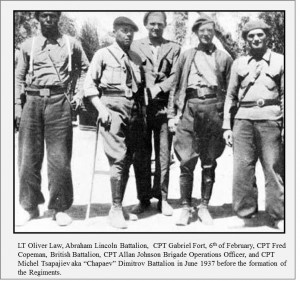

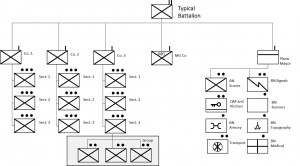
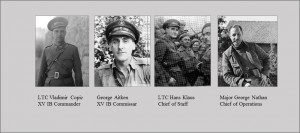
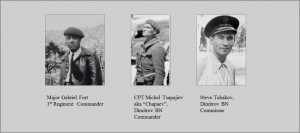
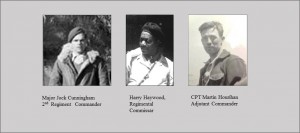
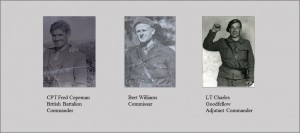
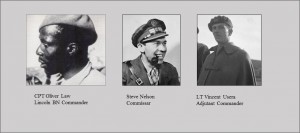















Fred Copeman in his book(Reason in Revolt) identified Michael Tsapaijev as Marshal Tito( Josip Broz) of Yugoslavia?!
How accurate was your information that this man was born in Budapest?How accurate is information that he joined Tito`s headquarters and participated in liberation of Belgrade?